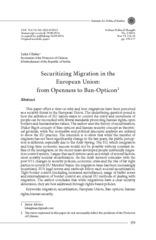Securitizing Migration in the European Union: from Openness to Ban-Opticon
Чланак у часопису (Објављена верзија)
Метаподаци
Приказ свих података о документуАпстракт
This paper offers a view on why and how migrations have been perceived as a security threat in the European Union. The underlining question posed is how the ambition of EU nation-states to control the entry and movement of people can be reconciled with liberal standards promoting human rights, open borders and humanitarian values. The author uses the theory of securitization, Didier Bigo’s concept of Ban-opticon and human security concept as theoretical grounds, while the normative and political discourse analyses are utilized to show the EU practice. The intention is to show that while the number of migrants has not been significantly change in the last years, the public perception is different, especially due to the Arab Spring. The EU, which integration and long-time economic success would not be possible without constant influx of the immigrants, in the recent years developed people unfriendly migration control system. I argue that such system came as a result of several factors, m...ost notably societal securitization. As the Arab turmoil coincides with the post 9/11 changes in security policies, economic crisis and the rise of far right parties in several EU Member States, the migration issue has been increasingly securitized. EU’s legal norms and methods follow such societal securitization. Tight border control (including increased surveillance), usage of buffer zones and externalization of border control are crucial EU methods of dealing with migration. The author concludes that while migrations have a clear security dimension, they are best addressed through rights-based policies.
Кључне речи:
migration / securitization / European Union / Ban-opticon / human rights / human securityИзвор:
Serbian Political Thought, 2014, 10, 2, 159-177Издавач:
- Institut za političke studije
Колекције
Институција/група
IFDTTY - JOUR AU - Glušac, Luka PY - 2014 UR - 314.74+341.43(4-672EU) UR - http://rifdt.instifdt.bg.ac.rs/123456789/2219 AB - This paper offers a view on why and how migrations have been perceived as a security threat in the European Union. The underlining question posed is how the ambition of EU nation-states to control the entry and movement of people can be reconciled with liberal standards promoting human rights, open borders and humanitarian values. The author uses the theory of securitization, Didier Bigo’s concept of Ban-opticon and human security concept as theoretical grounds, while the normative and political discourse analyses are utilized to show the EU practice. The intention is to show that while the number of migrants has not been significantly change in the last years, the public perception is different, especially due to the Arab Spring. The EU, which integration and long-time economic success would not be possible without constant influx of the immigrants, in the recent years developed people unfriendly migration control system. I argue that such system came as a result of several factors, most notably societal securitization. As the Arab turmoil coincides with the post 9/11 changes in security policies, economic crisis and the rise of far right parties in several EU Member States, the migration issue has been increasingly securitized. EU’s legal norms and methods follow such societal securitization. Tight border control (including increased surveillance), usage of buffer zones and externalization of border control are crucial EU methods of dealing with migration. The author concludes that while migrations have a clear security dimension, they are best addressed through rights-based policies. PB - Institut za političke studije T2 - Serbian Political Thought T1 - Securitizing Migration in the European Union: from Openness to Ban-Opticon IS - 2 VL - 10 SP - 159 EP - 177 UR - https://hdl.handle.net/21.15107/rcub_rifdt_2219 ER -
@article{
author = "Glušac, Luka",
year = "2014",
abstract = "This paper offers a view on why and how migrations have been perceived as a security threat in the European Union. The underlining question posed is how the ambition of EU nation-states to control the entry and movement of people can be reconciled with liberal standards promoting human rights, open borders and humanitarian values. The author uses the theory of securitization, Didier Bigo’s concept of Ban-opticon and human security concept as theoretical grounds, while the normative and political discourse analyses are utilized to show the EU practice. The intention is to show that while the number of migrants has not been significantly change in the last years, the public perception is different, especially due to the Arab Spring. The EU, which integration and long-time economic success would not be possible without constant influx of the immigrants, in the recent years developed people unfriendly migration control system. I argue that such system came as a result of several factors, most notably societal securitization. As the Arab turmoil coincides with the post 9/11 changes in security policies, economic crisis and the rise of far right parties in several EU Member States, the migration issue has been increasingly securitized. EU’s legal norms and methods follow such societal securitization. Tight border control (including increased surveillance), usage of buffer zones and externalization of border control are crucial EU methods of dealing with migration. The author concludes that while migrations have a clear security dimension, they are best addressed through rights-based policies.",
publisher = "Institut za političke studije",
journal = "Serbian Political Thought",
title = "Securitizing Migration in the European Union: from Openness to Ban-Opticon",
number = "2",
volume = "10",
pages = "159-177",
url = "https://hdl.handle.net/21.15107/rcub_rifdt_2219"
}
Glušac, L.. (2014). Securitizing Migration in the European Union: from Openness to Ban-Opticon. in Serbian Political Thought Institut za političke studije., 10(2), 159-177. https://hdl.handle.net/21.15107/rcub_rifdt_2219
Glušac L. Securitizing Migration in the European Union: from Openness to Ban-Opticon. in Serbian Political Thought. 2014;10(2):159-177. https://hdl.handle.net/21.15107/rcub_rifdt_2219 .
Glušac, Luka, "Securitizing Migration in the European Union: from Openness to Ban-Opticon" in Serbian Political Thought, 10, no. 2 (2014):159-177, https://hdl.handle.net/21.15107/rcub_rifdt_2219 .



